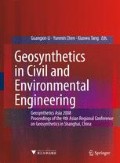Abstract
It has been evidenced in literature that time-dependant decrease of thickness under compressive loading affects the water flow capacity of geosynthetics. (2004) introduced a new method to estimate the long-term flow capacity of drainage geocomposites based on an estimation of the thickness reduction factor.
We propose to apply the same method to different families of geosynthetics used for drainage purposes. Two standard tests are used: EN 1897: Geotextiles and geotextile-related products — Determination of the compressive creep properties and EN ISO 12958: Geotextiles and geotextile-related products — Determination of water flow capacity in their plane.
For each geosynthetic, compressive creep properties are first determined. The long-term thickness reduction factor is derived from this first test. The stress-strain curve of the geosynthetic is then used to evaluate the stress corresponding to the reduced long-term thickness. This equivalent stress is finally applied to the water flow capacity test. A relationship is shown between creep strain and flow capacity reduction factor. We also show the magnitude of errors committed when using instantaneous water flow capacity without long-term effect correction.
Access this chapter
Tax calculation will be finalised at checkout
Purchases are for personal use only
Preview
Unable to display preview. Download preview PDF.
References
Böttcher RD (2006) Long-term flow capacity of geocomposites. Proc. 8th Int. Conf. on Geosynthetics, Yokohama: 423–426
Chai JC, Miura N, Nomura T (2004) Effect of hydraulic radius on long term drainage capacity of geosynthetics drains. Geotextiles and Geomembranes 22: 3–16
EN 1897 (2003) Geotextiles and geotextile-related products — Determination of the compressive creep properties. European Committee for Standardization
EN ISO 12958 (1999) Geotextiles and geotextile-related products — Determination of water flow capacity in their plane. European Committee for Standardization
EN ISO 9863-1 (2005) Geosynthetics — Determination of thickness at specified pressures — Part 1 — Single layers. European Committee for Standardization
Giroud JP, Zornberg JG, Zhao A (2000a) Hydraulic design of geosynthetic and granular liquid collection layers. Geosynthetics International 7(4–6): 285–380
Giroud JP, Zhao A, Richardson, GN (2000b) Effect of thickness reduction on geosynthetic hydraulic transmissivity. Geosynthetics International 7(4–6): 433–452
Gourc JP, Faure Y, Rollin A, Lafleur J (1982) Structural permeability law of geotextiles. Proc. 2nd Int. Conf. on Geotextiles, Las Vegas 1: 149–154
Jaisi DP, Glawe U, Bergado DT (2005) Hydraulic behaviour of geosynthetic and granular landfill drainage materials in the Sa Kaeo landfill, Thailand. Geotextiles and Geomembranes. 23: 185–204
Jarousseau C, Gallo R (2004) Drainage geocomposites: relation between water flow capacity and thickness in the long-term. Proc. 3rd European Geosynthetics Conf., Eurogeo3, Munich: 349–354
Koerner RM (1994) Designing with geosynthetics. 3rd edition. Prentice Hall
Mc Gown A, Kabir MH, Murray RT (1982) Compressibility and hydraulic conductivity of geotexiles. Proc. 2nd Int. Conf. on Geotextiles, Las Vegas 1: 167–172
Müller-Rochholtz J, Bronstein Z, Recker C, Diederich, R (2006) Influence of geotextile filters on the discharge capacity of geocomposite drainage materials in long term tests wit soil contact. Proc. 8th Int. Conf. on Geosynthetics, Yokohama: 427–430
Palmeira EM, Gardoni MG (2002) Drainage and filtration properties of non-woven geotextiles under confinement using different experimental techniques. Geotextiles and Geomembranes 20: 97–115
Sawicki A, Kazimierowicz-Frankowska K (1998) Creep behaviour of geosynthetics. Geotextiles and Geomembranes 16: 365–382
Author information
Authors and Affiliations
Editor information
Editors and Affiliations
Rights and permissions
Copyright information
© 2008 Zhejiang University Press, Hangzhou and Springer-Verlag GmbH Berlin Heidelberg
About this paper
Cite this paper
Duquennoi, C., Gallo, R., Thomas, A. (2008). Investigating the Relationship between Creep and Water Flow Capacity of Geosynthetics. In: Li, G., Chen, Y., Tang, X. (eds) Geosynthetics in Civil and Environmental Engineering. Springer, Berlin, Heidelberg. https://doi.org/10.1007/978-3-540-69313-0_1
Download citation
DOI: https://doi.org/10.1007/978-3-540-69313-0_1
Publisher Name: Springer, Berlin, Heidelberg
Print ISBN: 978-3-540-69312-3
Online ISBN: 978-3-540-69313-0
eBook Packages: EngineeringEngineering (R0)

